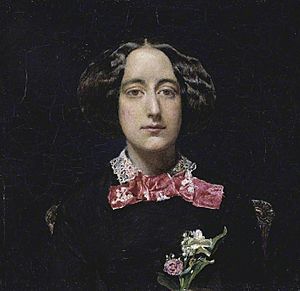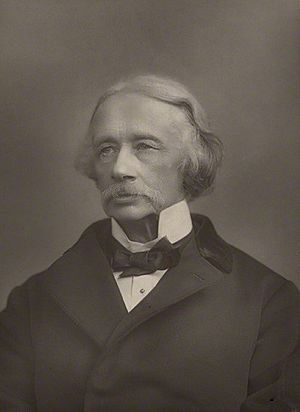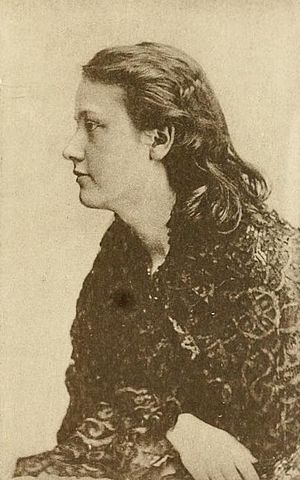Emily Augusta Patmore facts for kids
Quick facts for kids
Emily Augusta Patmore
|
|
|---|---|

John Everett Millais (1829-1896) - Mrs Coventry Patmore - 1010 - Fitzwilliam Museum
|
|
| Born |
Emily Augusta Andrews
29 February 1824 |
| Died | 5 July 1862 (aged 38) |
| Occupation | Writer |
| Spouse(s) | Coventry Patmore (1847 - 1862; her death) |
| Children | 6 |
Emily Augusta Patmore (née Andrews; 29 February 1824 – 5 July 1862) was a British writer. She was also a source of inspiration for a group of artists called the Pre-Raphaelite Brotherhood. Her life inspired a famous poem called The Angel in the House.
Contents
Emily's Early Life and Learning
Emily Augusta Andrews was born on February 29, 1824. Her father, Edward Andrews, was a minister in a Congregational church in London. Emily was one of 12 children in her family.
Family Connections
Some of Emily's siblings became quite famous. Her older brother, Edward William Andrews, moved to Australia. There, he became a successful newspaper owner and editor.
Emily also had four older sisters. One of them, Eliza, later became Eliza Orme. Her daughters grew up to be important women's rights activists.
- Emily Rosaline Orme was a leading suffragist in Edinburgh. A suffragist worked to get women the right to vote.
- Eliza Orme was the first woman in England to earn a law degree.
Emily's younger brother, Augustus Charles Andrews, worked at a bank. His daughter, Mabel Barltrop, later became a religious leader.
Education and Talents
Emily's mother passed away in 1831 when Emily was still young. Emily then took on many household duties for her father. It is believed that her father taught her Greek, Latin, and French. He also tutored John Ruskin, a famous art critic. Emily and her sister Eliza are credited with introducing Ruskin to the Pre-Raphaelite Brotherhood.
When Emily was about 10 years old, an artist named George Lance drew her portrait. This drawing is now called Emily Augusta Patmore at 10 years of age. It shows her head and shoulders, looking up slightly and smiling. The drawing is kept at the British Museum.
Marriage and a Famous Poem
Emily Augusta Andrews met the poet and critic Coventry Patmore after her father died in 1841. Her family had become very poor. She was living at her sister Eliza Orme's house in London. Eliza's husband, Charles Orme, was from a wealthy brewing family. Their home was a well-known meeting place for the Pre-Raphaelite artists.
Coventry Patmore worked as a librarian at the British Museum. He was part of many literary and artistic groups, including the Pre-Raphaelites. Emily Augusta Andrews and Coventry Patmore got married on September 11, 1847.
During their marriage, Coventry Patmore wrote a long poem. This poem was eventually put together into a famous work called The Angel in the House. Emily was the main inspiration for this poem.
Family Life and Beliefs
Emily was a strong Protestant, just like her father and grandfather. Coventry Patmore had different religious views. He was more interested in the high church style of the Anglican faith. However, he remained an Anglican during Emily's life. He did this out of respect for her wishes.
The Patmores had six children:
- Coventry (born 1848)
- Tennyson (born 1850)
- Emily Honoria (born 1853)
- Bertha (born 1855)
- Gertrude (born 1857)
- Henry John (born 1860)
Emily and Coventry also helped introduce Emily's niece, Emily Rosaline Orme, to her future husband, David Masson. This happened at gatherings at Emily's sister Eliza Orme's home.
Emily and the Pre-Raphaelites
Emily Patmore was very intelligent and beautiful. Her education and personality made her both an inspiration and a respected member of the Pre-Raphaelite group of friends.
Artistic Portrayals
- Artist Thomas Woolner created a medallion of Emily.
- John Everett Millais painted her portrait in 1851. This painting is called Mrs. Coventry Patmore and is now at the Fitzwilliam Museum in Cambridge.
- John Brett also painted a portrait of Mrs. Patmore. It was shown at the Royal Academy of Arts in 1856. This painting is now at the Ashmolean Museum in Oxford.
- The poet Robert Browning was also inspired by Emily. He wrote a poem called "A Face" about her.
Emily's Writing Career
Emily Patmore wrote and published three books. She used the pen name Mrs Motherly for her works.
Books for Young People
In 1859, she published The Servant's Behaviour Book, or, Hints on Manners and Dress for Maid Servants in Small Households. This book gave advice to women working as domestic servants. It was written in a clear and helpful way.
Her other two books were more literary.
- Nursery Poetry (1859) contained lively poems about everyday household topics.
- Nursery Tales (1860) had stories that aimed to teach good morals and behavior.
Emily is also thought to have played a big part in creating The Children's Garland (1862). This was a collection of poems put together by her husband.
Emily's Death
Emily Patmore passed away from tuberculosis on July 5, 1862. She was at her home in Hampstead, London. She was only thirty-eight years old and left behind her six young children.
She was buried at St Mary's Churchyard, Hendon, London. After her death, her husband converted to Catholicism. Their daughter Emily later became a nun.



